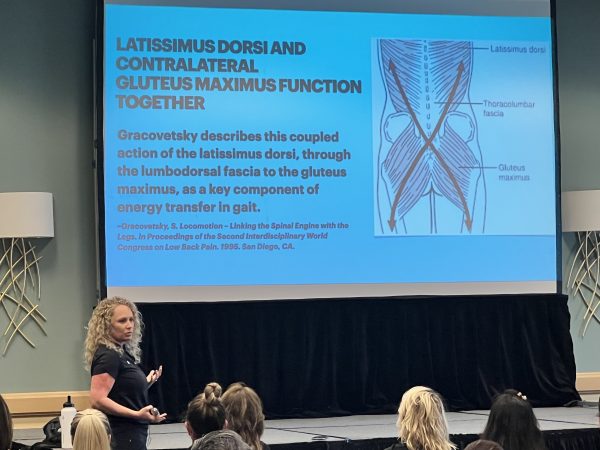Why Glute Training Is Better When You Connect the Core
2025-01-8
When we talk about glute training, most people think of hip thrusts and other isolated movements aimed at building strength or aesthetics. While those exercises “work” the glutes, they often miss the bigger picture of how the glutes truly function. To get the most out of your glute training, it’s essential to focus not only on the glutes themselves but also on how they interact with the rest of the body—especially the core, the lower body kinetic chain, and the posterior oblique sling.

The Role of the Posterior Oblique Sling in Glute Function
The posterior oblique sling is a system of interconnected muscles, fascia, and connective tissues that span the body diagonally. It includes the gluteus maximus, latissimus dorsi, and thoracolumbar fascia. This sling is essential for transferring force between the upper and lower body, stabilizing the pelvis, and powering rotational and lateral movements.

When you train the glutes in isolation without involving the core or addressing this sling, you limit their functionality. For example, during activities like running, jumping, or even walking, the glutes don’t work alone—they rely on the coordination of the posterior oblique sling to create power and stability. Integrating the core into your glute training ensures this system is activated, improving both glute function and overall movement efficiency.
The Core-Glute Connection
The core plays a crucial role in glute activation because it stabilizes the pelvis and spine, providing a solid foundation for the glutes to work effectively. Without proper core engagement, the pelvis may tilt or rotate excessively during movement, leading to inefficient glute activation and potentially contributing to low back or knee pain.
Exercises like single-leg deadlifts, step-ups, and lateral lunges become far more effective when you consciously connect the core. Incorporating tools like resistance bands, kettlebells, and Ultimate Sandbags can further enhance this connection by challenging stability and requiring the core and glutes to work together.
The Kinetic Chain and Glute Function
The glutes don’t operate in isolation; they are part of a kinetic chain that includes the feet, ankles, knees, and hips. Dysfunction in any part of this chain can limit glute function and lead to compensations that reduce strength and increase injury risk. For instance, if the foot lacks mobility or stability, it can affect how the glutes engage during activities like lunging or squatting.
To optimize glute training, start from the ground up. A stable and mobile foot creates a solid base of support, allowing for better force transfer through the lower body. Exercises that emphasize foot engagement—such as barefoot training, single-leg work, or drills in different positions and stances—can help improve this connection and enhance glute activation.
Glutes as Triplanar Muscles
The glutes are triplanar muscles, meaning they function across all three planes of motion: sagittal (forward and backward), frontal (side to side), and transverse (rotational). Traditional exercises often emphasize the sagittal plane, but neglecting the frontal and transverse planes limits the glutes’ ability to function optimally in real-world scenarios.
Single-leg movements like step-ups, lunges, and lateral step-downs are particularly effective for training the glutes in all planes of motion. They also engage stabilizing muscles in the hips and core, making them more functional and transferable to daily life and athletic activities.
For example, adding a rotational component to a lunge or incorporating lateral banded movements can challenge the glutes in ways that mimic real-world movement patterns. These variations not only build strength but also improve stability and coordination.
Practical Tips for Integrating Core and Glute Training
-Start with Stability: Focus on core stability exercises like planks, side planks, or anti-rotation holds to establish a strong foundation. Progress to dynamic movements that require core engagement, such as Pallof presses or bird dogs.
-Incorporate Single-Leg Work: Exercises like split squats, Bulgarian split squats, or single-leg deadlifts are excellent for engaging the posterior oblique sling and challenging the glutes in multiple planes.
-Use Tools to Enhance Feedback: Tools like resistance bands, kettlebells, and Ultimate Sandbags can help create better feedback for core and glute engagement. For example, a band around the knees during a glute bridge can encourage proper alignment and activation, while kettlebells and Ultimate Sandbags are used differently to make that connection to the Posterior Oblique Sling
-Train Barefoot or with Minimal Shoes: Training barefoot or with minimal footwear helps improve foot mobility and stability, creating a stronger foundation for the lower body kinetic chain.
-Add Multiplanar Movements: Incorporate exercises that challenge the glutes in all planes of motion. Try lateral lunges, curtsy lunges, or rotational step-ups for a more dynamic approach.
-Focus on Deceleration Strength: Movements like step-downs or controlled eccentric lunges improve the glutes’ ability to absorb force, a critical function for preventing injuries and enhancing performance. See how to accomplish much of the above in drills Cory Cripe shows below.
Understanding Building Better Glute Workouts
Glute training is about more than building strong, aesthetic muscles—it’s about creating a functional, resilient body. By connecting the core and emphasizing the posterior oblique sling, you enhance not only the glutes’ performance but also the stability and strength of your entire body. Additionally, addressing the role of the feet and lower body kinetic chain ensures that you’re training the glutes in a way that reflects their real-world function.
The next time you hit the gym, think beyond isolated glute exercises. Incorporate movements that connect the core, challenge stability, and engage the glutes across all planes of motion. Your body will thank you for it—not just with stronger glutes, but with better overall performance and reduced risk of injury.
Learn so many more great strategies in our upcoming Progressive Kettlebell Movement masterclass starting January 14th! Just 48 hours to save on our early bird price to join this great educational event with CEUs, our PKM swing course for FREE, and amazing coaching! Don’t miss, join us HERE!
© 2025 Ultimate Sandbag Training. Site by Jennifer Web Design.







